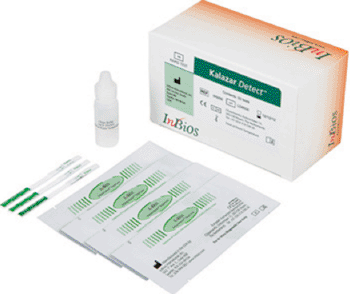Blood Sampling Compared for Leishmaniasis Rapid Test
By LabMedica International staff writers
Posted on 11 Jul 2013
Antibody-detecting rapid diagnostic tests (RDTs) are available to aid in the diagnosis of visceral leishmaniasis (VL), the second most fatal parasitic disease after malaria. Posted on 11 Jul 2013
Although these RDTs have been developed, validated, and approved for use with serum, they are universally performed using whole blood and therefore it was deemed necessary to determine whether an established RDT is as sensitive on whole blood as on serum.

Image: Kalazar Detect Test for Leishmaniasis (Photo courtesy of InBios International).
Tropical medicine specialists at McGill University (Montreal, QC, Canada) working with colleagues at the Rajendra Memorial Research Institute of Medical Sciences (Patna, India) compared serum and blood samples from 624 individuals with symptoms of VL attending the outpatient clinic. They used the rK39 immunochromatographic RDT to assess and evaluate the blood and serum samples from each patient. The test was considered positive when both the control line and the test line appeared red in color.
The rK39 Kalazar Detect RTD (InBios International; USA; Seattle, WA, USA) detected 251 cases who were seropositive on both blood and serum sample. In comparison, 334 were negative on both serum and blood. Notably, there were 26 cases that were negative on blood and positive on serum. These 26 individuals in general had low titer antibodies against rK39 as determined by an enzyme linked immunosorbent assay (ELISA) and follow-up on most of these individuals revealed none had persistent VL symptoms. There were 13 cases that were positive on blood and negative on serum and these were considered to be false positives.
The authors concluded that the major observation from their study was that the concordance of the rK39 RDT performed on serum versus blood was excellent. The test can however be negative on blood and positive on serum when the titer of anti-K39 antibodies is low. We therefore recommend that when an individual from an endemic area has clinical symptoms of VL and the blood rK39 RDT is negative, that the test should be redone two to three weeks later if the symptoms persist since during this interval the titer may increase if the disease begins to progress. The study was published on May 23, 2013, in the journal Public Library of Science Neglected Tropical Diseases.
Related Links:
McGill University
Rajendra Memorial Research Institute of Medical Sciences
InBios International









 Analyzer.jpg)




